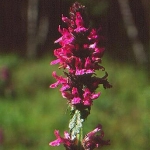| Medicinal Uses: |
Internally for headaches associated with debility and nervous tension, and for anxiety, neuralgia, sinusitis, upper respiratory tract mucus, gastritis, poor digestion, hypertension, and menopausal problems. Externally for wounds (especially if infected), bruises, ulcers, sore throat, and gum inflammation. Combines well with Hypericum perforatum (See, Perforate St. John's Wort), Lavandula angustifolia (See, Lavender), Scutellaria laterifolia (See, Virginia Skullcap), or Verbena officinalis (See, Vervain) for tension headaches.
To treat asthma, bronchitis, anxiety, diarrhea, gout, and heartburn; as a sedative. |
| Drug Interactions: |
| Taking wood betony with these drugs may increase the risk of hypotension (excessively low blood pressure): |
| Acebutolol, (Novo-Acebutolol, Sectral) |
Amlodipine, (Norvasc) |
Atenolol, (Apo-Atenol, Tenormin) |
Benazepril, (Lotensin) |
Betaxolol, (Betoptic S, Kerlone) |
| Bisoprolol, (Monocor, Zebeta) |
Bumetanide, (Bumex, Burinex) |
Candesartan, (Atacand) |
Captopril, (Capoten, Novo-Captopril) |
Carteolol, (Cartrol, Ocupress) |
| Carvedilol, (Coreg) |
Chlorothiazide, (Diuril) |
Chlorthalidone, (Apo-Chlorthalidone, Thalitone) |
Clonidine, (Catapres, Duraclon) |
Diazoxide, (Hyperstat, Proglycem) |
| Diltiazem, (Cardizem, Tiazac) |
Doxazosin, (Alti-Doxazosin, Cardura) |
Enalapril, (Vasotec) |
Eplerenone, (Inspra) |
Eprosartan, (Teveten) |
| Esmolol, (Brevibloc) |
Felodipine, (Plendil, Renedil) |
Fenoldopam, (Corlopam) |
Fosinopril, (Monopril) |
Furosemide, (Apo-Furosemide, Lasix) |
| Guanabenz, (Wytensin) |
Guanadrel, (Hylorel) |
Guanfacine, (Tenex) |
Hydralazine, (Apresoline, Novo-Hylazin) |
Hydrochlorothiazide, (Apo-Hydro, Microzide) |
| Hydrochlorothiazide and Triamterene, (Dyazide, Maxzide) |
Indapamide, (Lozol, Nu-Indapamide) |
Irbesartan, (Avapro) |
Isradipine, (DynaCirc) |
Labetalol, (Normodyne, Trandate) |
| Lisinopril, (Prinivil, Zestril) |
Losartan, (Cozaar) |
Mecamylamine, (Inversine) |
Mefruside, (Baycaron) |
Methyclothiazide, (Aquatensen, Enduron) |
| Methyldopa, (Apo-Methyldopa, Nu-Medopa) |
Metolazone, (Mykrox, Zaroxolyn) |
Metoprolol, (Betaloc, Lopressor) |
Minoxidil, (Loniten, Rogaine) |
Moexipril, (Univasc) |
| Nadolol, (Apo-Nadol, Corgard) |
Nicardipine, (Cardene) |
Nifedipine, (Adalat CC, Procardia) |
Nisoldipine, (Sular) |
Nitroglycerin, (Minitran, Nitro-Dur) |
| Nitroprusside, (Nipride, Nitropress) |
Olmesartan, (Benicar) |
Oxprenolol, (Slow Trasicor, Trasicor) |
Perindopril Erbumine, (Aceon, Coversyl) |
Phenoxybenzamine, (Dibenzyline) |
| Phentolamine, (Regitine, Rogitine) |
Pindolol, (Apo-Pindol, Novo-Pindol) |
Polythiazide, (Renese) |
Prazosin, (Minipress, Nu-Prazo) |
Propranolol, (Inderol, InnoPran XL) |
| Quinapril, (Accupril) |
Ramipril, (Altace) |
Reserpine, (Reserpine) |
Spironolactone, (Aldactone, Novo-Spiroton) |
Telmisartan, (Micardis) |
| Terazosin, (Alti-Terazosin, Hytrin) |
Timolol, (Betimol, Timoptic) |
Torsemide, (Demadex) |
Trandolapril, (Mavik) |
Triamterene, (Dyrenium) |
| Trichlormethiazide, (Metatensin, Naqua) |
Valsartan, (Diovan) |
Verapamil, (Calan, Isoptin SR) |
|
